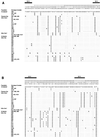Phylogenetic relationships of varieties and geographical groups of the human pathogenic fungus Histoplasma capsulatum Darling
- PMID: 9986828
- PMCID: PMC84508
- DOI: 10.1128/JCM.37.3.653-663.1999
Phylogenetic relationships of varieties and geographical groups of the human pathogenic fungus Histoplasma capsulatum Darling
Abstract
The phylogeny of 46 geographically diverse Histoplasma capsulatum isolates representing the three varieties capsulatum, duboisii, and farciminosum was evaluated using partial DNA sequences of four protein coding genes. Parsimony and distance analysis of the separate genes were generally congruent and analysis of the combined data identified six clades: (i) class 1 North American H. capsulatum var. capsulatum, (ii) class 2 North American H. capsulatum var. capsulatum, (iii) Central American H. capsulatum var. capsulatum, (iv) South American H. capsulatum var. capsulatum group A, (v) South American H. capsulatum var. capsulatum group B, and (vi) H. capsulatum var. duboisii. Although the clades were generally well supported, the relationships among them were not resolved and the nearest outgroups (Blastomyces and Paracoccidioides) were too distant to unequivocally root the H. capsulatum tree. H. capsulatum var. farciminosum was found within the South American H. capsulatum var. capsulatum group A clade. With the exception of the South American H. capsulatum var. capsulatum group A clade, genetic distances within clades were an order of magnitude lower than those between clades, and each clade was supported by a number of shared derived nucleotide substitutions, leading to the conclusion that each clade was genetically isolated from the others. Under a phylogenetic species concept based on possession of multiple shared derived characters, as well as concordance of four gene genealogies, H. capsulatum could be considered to harbor six species instead of three varieties.
Figures






References
-
- Ajello L. Histoplasmosis—a dual entity: histoplasmosis capsulati and histoplasmosis duboisii. Ig Mod. 1983;79:3–30.
-
- Ajello L, Kuttin E S, Beemer A M, Kaplan W, Padhye A. Occurrence of Histoplasma capsulatum Darling, 1906 in Israel, with a review of the current status of histoplasmosis in the Middle East. Am J Trop Med Hyg. 1977;26:140–147. - PubMed
-
- Avise J C, Ball R M., Jr Principles of genealogical concordance in species concepts and biological taxonomy. Oxf Surv Evol Biol. 1990;7:45–67.
-
- Baum D A, Donoghue M J. Choosing among alternative “phylogenetic” species concepts. Syst Bot. 1995;20:560–573.
Publication types
MeSH terms
Substances
Grants and funding
LinkOut - more resources
Full Text Sources
Other Literature Sources
Medical

